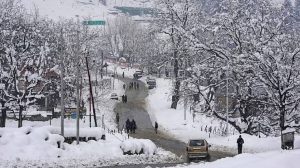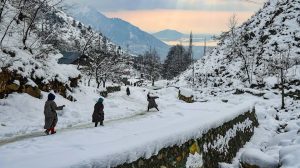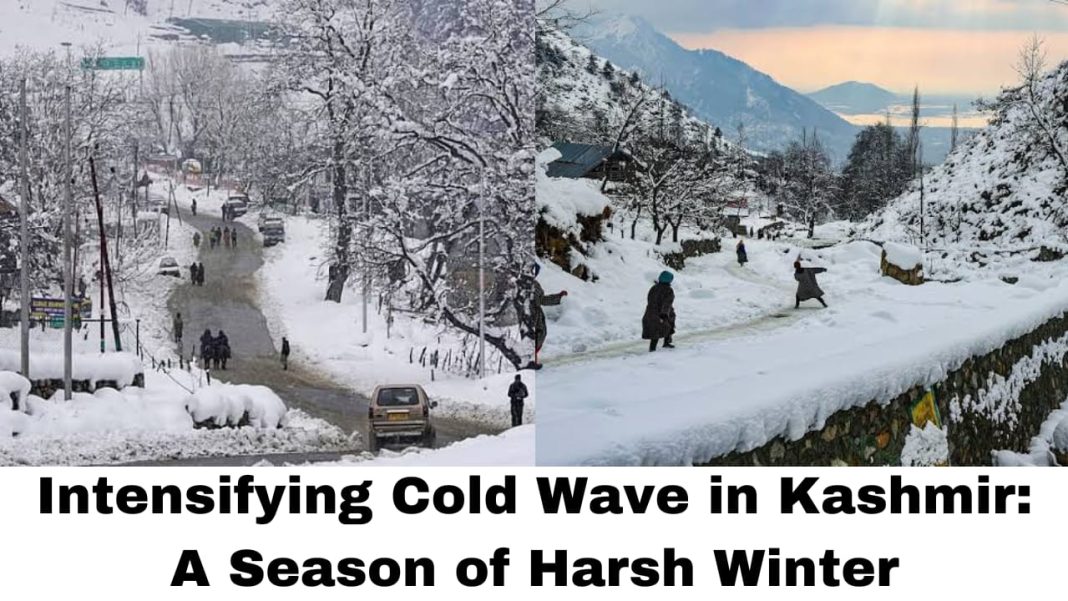Digital News Guru Kashmir Desk:
The Kashmir Valley, known for its breathtaking landscapes and serene beauty, is currently grappling with an intensifying cold wave that has disrupted daily life and brought a challenging winter to its residents. Temperatures across the region have plummeted, with some areas experiencing record-breaking lows. This extreme weather is a part of the annual ‘Chillai Kalan,’ the harshest 40-day winter period, which spans from December 21 to January 29. However, the current severity has heightened concerns among both locals and authorities.
Plummeting Temperatures Across the Kashmir region
The capital city, Srinagar, recorded a freezing temperature of -4.4°C, while Qazigund, known as the gateway town to the Valley, dropped to a chilling -6.2°C. The popular tourist destination, Pahalgam, famous for its pristine beauty, reported an alarming low of -10.4°C. These temperatures have not only disrupted daily life but also turned water bodies into sheets of ice. Lakes, ponds, and even water supply lines have frozen solid, creating challenges for residents in accessing clean water.

The Meteorological Department (MeT) has issued a yellow alert, cautioning about isolated cold wave conditions that are expected to persist until January 10. Although dry weather is anticipated in the coming days, a spell of light rain and snow is forecasted for January 11. This brief relief, however, is unlikely to completely alleviate the ongoing cold wave.
Impact on Daily Life
The intensifying cold wave has caused significant disruptions to daily routines. Schools and educational institutions have reported low attendance as freezing temperatures deter students and staff from venturing out. Transport services have also been affected, with frost-covered roads posing a hazard for drivers and leading to delays in public transit schedules.
Frozen water supply lines have become a widespread issue in residential areas, forcing families to rely on alternative sources of water. The cost of heating has surged as people try to combat the biting cold, putting additional financial pressure on households already struggling with economic challenges.
Tourism: A Mixed Bag
Kashmir’s winters often attract tourists eager to experience snowfall and the pristine beauty of the snow-clad Himalayas. However, the extreme cold wave has created a paradoxical situation. While destinations like Gulmarg and Pahalgam see an influx of tourists enjoying winter sports and scenic views, the freezing conditions have led to cancellations and disruptions in travel plans for others. Tour operators are working overtime to ensure that tourists have a safe and comfortable experience despite the challenges.
‘Chillai Kalan’: Tradition and Challenges
The period of ‘Chillai Kalan’ holds cultural and ecological significance for Kashmiris. It is during this time that the region witnesses its coldest and most challenging weather. The heavy snowfall replenishes water bodies and ensures the vitality of rivers and streams, which are crucial for agriculture and hydroelectric projects in the region. However, the harsh conditions also test the resilience of the people.
Many families rely on traditional heating methods, such as the ‘kangri,’ a portable clay firepot that has been a staple in Kashmiri households for centuries. While effective, these methods pose risks, including carbon monoxide poisoning and accidental burns. Modern heating solutions, though safer, remain inaccessible to many due to high costs.
Government Measures and Public Response
The government and local authorities have taken several measures to mitigate the impact of the cold wave. Relief efforts include the distribution of blankets and warm clothing to vulnerable populations, along with efforts to restore frozen water supply lines. The Meteorological Department continues to provide regular weather updates to help residents prepare for the worst.

Public response has been one of resilience and adaptability. Communities have come together to assist those in need, offering shelter, food, and warmth to the less fortunate. Social media platforms have become a vital tool for spreading awareness and coordinating aid efforts.
Looking Ahead
As the Valley endures the harsh realities of winter, the cold wave serves as a reminder of the region’s vulnerability to extreme weather. While the picturesque snowfall might enchant onlookers, the challenges faced by the people of Kashmir are a testament to their strength and perseverance. With proper planning, timely relief efforts, and community support, the Valley hopes to navigate through this cold wave and look forward to a warmer, more hospitable season ahead.
This intensifying cold wave not only underscores the challenges posed by nature but also highlights the resilience of the people of Kashmir. It serves as a reminder of the importance of preparedness and support in the face of extreme weather conditions.
You May Also Read: Arvind Kejriwal Advocates for Jat Inclusion in Central OBC List








